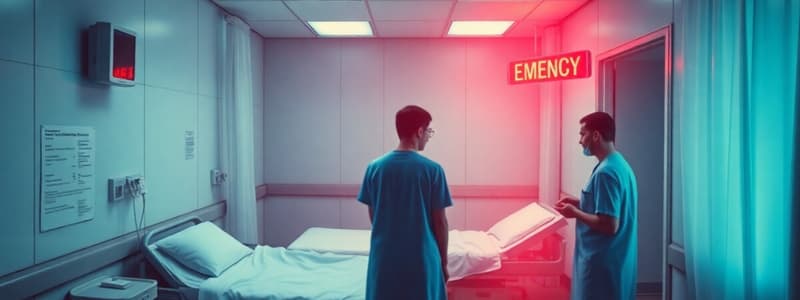Podcast
Questions and Answers
For accurate patient identification, which data points should be used?
For accurate patient identification, which data points should be used?
- Medical Record Number (MRN), UHID, UID, CR number, IP number (correct)
- Bed Number
- Patient's age and gender
- Room number and date of birth
A patient's fall resulting in a hip fracture is classified as what type of event?
A patient's fall resulting in a hip fracture is classified as what type of event?
- Reportable event
- Near miss
- Sentinel event (correct)
- Minor adverse event
What does 'Code Pink' typically indicate in a healthcare setting?
What does 'Code Pink' typically indicate in a healthcare setting?
- Infant abduction (correct)
- Adult abduction
- Hazardous spill
- Child abduction (older than 12 months)
Which patient populations are generally considered most vulnerable and require heightened attention in healthcare settings?
Which patient populations are generally considered most vulnerable and require heightened attention in healthcare settings?
What do the acronyms NABH and QCI stand for in the context of healthcare accreditation?
What do the acronyms NABH and QCI stand for in the context of healthcare accreditation?
Disposable gloves, caps, gowns, face masks, and eye wear are categorized under what type of safety measures?
Disposable gloves, caps, gowns, face masks, and eye wear are categorized under what type of safety measures?
Which of the following is typically included as a fundamental patient right in healthcare settings?
Which of the following is typically included as a fundamental patient right in healthcare settings?
Under which emergency code does a fire alert typically fall?
Under which emergency code does a fire alert typically fall?
To properly disinfect a spill area, a _____ bleach solution should be left for at least _____ minutes.
To properly disinfect a spill area, a _____ bleach solution should be left for at least _____ minutes.
What is the most essential and frequently performed measure to control infection spread in healthcare facilities?
What is the most essential and frequently performed measure to control infection spread in healthcare facilities?
Which of the following event corresponds with emergency dial number?
Which of the following event corresponds with emergency dial number?
What does the acronym RACE stand for in the context of fire safety protocols?
What does the acronym RACE stand for in the context of fire safety protocols?
Which of the following can be used to extinguish a fire?
Which of the following can be used to extinguish a fire?
Is there any alternative available for standard precautions?
Is there any alternative available for standard precautions?
A surgical site infection (SSI) occurring in the muscles of a patient is classified as:
A surgical site infection (SSI) occurring in the muscles of a patient is classified as:
Which of the following is included in the documents related to access, assessment, and continuity of care?
Which of the following is included in the documents related to access, assessment, and continuity of care?
Agents requiring ____ level of biosafety facilities and practices are extremely dangerous and pose a high risk of life-threatening disease.
Agents requiring ____ level of biosafety facilities and practices are extremely dangerous and pose a high risk of life-threatening disease.
Which of the following is part of standard precautions?
Which of the following is part of standard precautions?
When is it essential to observe standard precautions in a healthcare setting?
When is it essential to observe standard precautions in a healthcare setting?
According to the World Health Organization (WHO), what are the five moments for hand hygiene?
According to the World Health Organization (WHO), what are the five moments for hand hygiene?
Flashcards
Patient Identification data
Patient Identification data
MRN No.(UHID/UID/ CR no. IP no.)
Sentinel events
Sentinel events
Patient falling results in hip fracture is a sentinel event.
Code pink
Code pink
Code pink is Infant abduction.
Who are vulnerable patients?
Who are vulnerable patients?
Signup and view all the flashcards
NABH & QCI
NABH & QCI
Signup and view all the flashcards
Disposable gloves, caps, gowns, Face masks and eye wear
Disposable gloves, caps, gowns, Face masks and eye wear
Signup and view all the flashcards
Patient rights
Patient rights
Signup and view all the flashcards
Fire alert comes under which emergency codes?
Fire alert comes under which emergency codes?
Signup and view all the flashcards
Fire can be extinguished by using...
Fire can be extinguished by using...
Signup and view all the flashcards
When to observe standard precautions?
When to observe standard precautions?
Signup and view all the flashcards
WHO five moments of hand hygiene
WHO five moments of hand hygiene
Signup and view all the flashcards
Which cleaning method is not recommended in Wards and ICU?
Which cleaning method is not recommended in Wards and ICU?
Signup and view all the flashcards
Common Causes of Needle Stick Injuries
Common Causes of Needle Stick Injuries
Signup and view all the flashcards
What to do in case of needle stick injuries?
What to do in case of needle stick injuries?
Signup and view all the flashcards
ISBAR tool is used as communication tool in healthcare organizations
ISBAR tool is used as communication tool in healthcare organizations
Signup and view all the flashcards
Biological spores used in steam sterilization
Biological spores used in steam sterilization
Signup and view all the flashcards
When should you use PDCA process
When should you use PDCA process
Signup and view all the flashcards
Please put the correct sequence of steps of hand hygiene.
Please put the correct sequence of steps of hand hygiene.
Signup and view all the flashcards
Study Notes
Patient Identification
- MRN (Medical Record Number), UHID (Unique Health Identification Number), UID (Unique Identification Number), CR number, and IP number, are all acceptable data for patient identification.
- Bed number is insufficient for patient identification.
Hip Fracture
- A patient fall resulting in a hip fracture is classified as a sentinel event.
Code Pink
- Code pink indicates infant abduction.
Vulnerable Patients
- Vulnerable patients include those under 16 years and over 65 years.
NABH and QCI
- NABH (National Accreditation Board for Hospitals & Healthcare Providers) and QCI (Quality Council of India).
PPE (Personal Protective Equipment)
- Disposable gloves, caps, gowns, face masks, and eye wear are all forms of personal protective equipment (PPE).
Patient Rights
- Patient rights include confidentiality/privacy, dignity, and access to information.
Fire Emergency
- Code Red indicates Fire alert
Disinfection
- A 5% bleach solution needs to be left on a spill area for 20 minutes to properly disinfect.
Infection Control
- Hand-washing is the most important and frequently taken measure to control infection.
Emergency Codes
- Emergency event code dial number is for emergency events
- Cardiac arrest/patient collapse follows the emergency code
- Fire is an emergency code
- Security threat (fight) is an emergency code
RACE Acronym
- RACE stands for Rescue, Alarm, Confine and Extinguish/Evacuate.
Extinguishing Fire
- Fire can be extinguished by using a fire extinguisher, sprinkler system, or fire hydrant system.
Standard Precautions
- There is no alternative to standard precautions.
Surgical Site Infections (SSI)
- A surgical site infection occurring at the muscles of the patient is classified as a deep incisional SSI.
Documents for Access, Assessment, and Continuity of Care
- Documents related to access, assessment, and continuity of care include:
- Uniform care policy
- Handling of medico-legal cases
- Triage of patients in emergency
- Managing dead on arrival cases
- Identification of likely community emergencies, epidemics, and disasters likely
Biosafety Levels
- Agents requiring the highest level of biosafety facilities and practices are extremely dangerous and pose a high risk of life-threatening disease.
Standard Precautions Components
- Components of standard precautions include:
- Hand hygiene
- Use of personal protective equipment (PPE) like cap, mask, gloves, aprons, gowns, whenever
- Indicated during patient care
- Immunization of health care worker against hepatitis B
- Proper biomedical waste management
- Proper handling and disposal of sharps
Observing Standard Precautions
- Standard precautions should be observed for all patients at all times.
WHO Five Moments of Hand Hygiene
- The WHO five moments of hand hygiene are:
- Before touching a patient
- Before clean/aseptic procedure
- After body fluid exposure risk
- After touching a patient
- After touching patient surroundings
Hand Hygiene Steps
- Correct sequence of steps of hand hygiene:
- Rub hands palm to palm (A)
- Right palm over left dorsum with fingers interlaced and vice versa (B)
- Palm to palm with fingers interlaced (C)
- Back of fingers to opposing palm with fingers interlocked (D)
- Rotational rubbing backwards and forwards with clasped fingers of right hand in left palm and vice versa (F)
- Rotational rubbing of the left thumb clasped in right palm and vice versa (E)
- Wrists (G)
- Correct Sequence is: A, B, D, C, F, G
Cleaning Methods
- Wet mopping is not recommended for cleaning in Wards and ICUs
Biosafety Levels
- Ebola virus, the Lassa virus, and any agent with unknown risks of pathogenicity and transmission falls under the highest biosafety level.
Medication Errors
- Medication errors include:
- Prescribing errors
- Omission errors
- Wrong time errors
- Unauthorized drug errors
- Improper dose errors
- Wrong dose prescription/wrong dose preparation errors
Needle Stick Injuries
- Common causes of needle stick injuries or exposure of mucous membranes to infectious material:
- Recapping of needles
- PPE not used wherever indicated
- Improper disposal (wrong segregation) of biomedical waste in wrong color-coded bags
Actions After Needle Stick Injury
- In case of needle stick injury or exposure of mucous membrane to infectious material:
- First aid: wash the site with lots of water and soap
- Immediate reporting to the department
- Post-exposure prophylaxis whenever required
- Reporting of serological investigations to HIC (Hospital Infection Control) department
ISBAR Tool
- YES, ISBAR tool is used as a communication tool in healthcare organizations.
Steam Sterilization
- Geobacillus stearothermophilus biological spores are used in the steam sterilization process.
PDCA Process
- The PDCA (Plan, Do, Check, Act) process should be used when:
- Exploring and testing multiple solutions in a small, controlled trial
- Avoiding waste by catching and adapting ineffective solutions before rolling them out on a large scale
- Implementing change and continuous improvement
- Implementing total quality management or six Sigma initiatives
- Developing or improving a process
Biomedical Waste Segregation
- Follow BMW policy for biomedical waste segregation (Red bag, yellow bag, sharp box)
Hospital Disinfectant
- Name one disinfectant mostly used in hospital:
Spillage Emergency Actions
- Action taken for spillage emergency:
Code Violet Indication
- Code violet indicates for:
Quality Indicators in Imaging Services
- Formula used for quality indicators in imaging services:
Compressions and Breaths in CPR
- How many compression___________ for breaths__________ / cycles
Studying That Suits You
Use AI to generate personalized quizzes and flashcards to suit your learning preferences.





